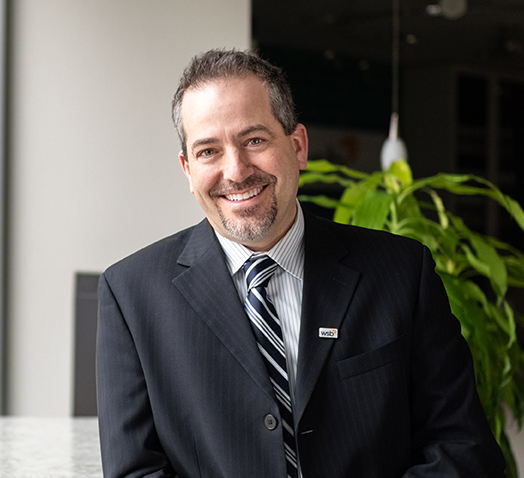March 13, 2023
By Sean Delmore, Director of Traffic, WSB
Traffic signals are an often-overlooked aspect of everyday life. But when you stop at a traffic signal, did you ever also stop and think about how, where, and why these signals are used? Here are six things you may not know about traffic signals.
When is a traffic signal needed?
Communities thoughtfully decide where traffic signals are needed vs. roundabouts or stop signs. An Intersection Control Evaluation (ICE) is conducted to determine the appropriate method of traffic control, which includes a detailed signal warrant analysis. These studies measure the existing vehicular and non-motorized (pedestrian/bicycle) traffic volumes and evaluate crash history at the intersection. WSB traffic experts conduct these evaluations in partnership with communities and local governments to collect the necessary data and determine if a signal would help improve the traffic safety and operations of the area.
Traffic signals are typically designed to last more than 20 years with routine maintenance and designed to handle forecasted traffic volumes 20 years out. The federal government has requirements that must be followed when planning for the installation of new signals. These requirements include signal warrants that are found in the Manual on Uniform Traffic Control Devices (MUTCD).
What are the benefits of a traffic signal?
Efficiency and safety are the top benefits of traffic signals. Signals are designed to keep up the progression of heavy traffic while ensuring there are no undue delays to side streets. The signals imitate elements of human decision-making, such as when a pedestrian should cross a busy intersection or when it is safe for a vehicle to make a left turn. Removing that decision from the person and incorporating it into an automated system like the traffic signal increases the overall safety for vehicles and pedestrians.
The ability to efficiently manage traffic flow can also be a significant factor in the success of local businesses and the livability of an area for families. For instance, access management developed by signals reduces the chaos of vehicles entering and existing businesses onto the main corridor.
How do traffic signals communicate with emergency vehicles?
Traffic signals can change to the green phase for emergency vehicles allowing them to respond quickly and safely to incidents. Most emergency vehicles have an emitter on the dashboard that communicates with the traffic signal to safely end an opposing signal phase and bring up a green indication for the emergency vehicle. The technology also will extend the length of a green cycle if it is currently green for the direction an emergency vehicle is travelling.
Why do traffic signals always turn red for me?
Despite what we sometimes think, not all traffic signals turn red as you approach— in fact, it is just the opposite. Traffic signals have “dilemma zone protection,” which extends the length of a green light when a vehicle passes the back detection as it approaches the light. This keeps the light green to eliminate the human dilemma of whether to speed up or stop when the light turns yellow.
Additionally, sensors in the ground at the intersection detect cars as they approach. For example, in many signalized locations, a minor street with lower vehicle volumes won’t change to green unless a vehicle is waiting at the red light to maximize the efficiency of the major roadway.
What’s the latest innovation with traffic signals?
Flashing yellow arrows are one of the latest innovations in traffic signals. The flashing yellow arrow allows the driver to decide when it is appropriate to turn left, as opposed to controlling left-turns with green and red arrows. This feature on signals may also change based on the time of day. For example, the flashing yellow left turn arrow may be used on a Sunday night when traffic volumes are significantly lower. Then, during Monday morning rush hour, when traffic volumes increase substantially, the flashing yellow arrow will not be utilized, and the signal can offer a protected only phase because there is too great a risk posed to left turning vehicles trying to find an acceptable gap against the amount of oncoming traffic.
What’s on the horizon for traffic signals?
One element of future traffic signals being considered more and more in major metropolitan areas is incorporating pedestrians and cyclists into the signal system. Engineers are rethinking classic intersection designs to incorporate new technology such as Audible Pedestrian Signals (APS) & ADA compliant curb ramp improvements, as well as bicycle markings for improving safety and accessibility for all modes.
How WSB Can Help
If you have concerns or complaints about an intersection, WSB’s team of experts are here to help. We can perform an Intersection Control Evaluation or provide suggestions how to move traffic safely and efficiently through your community.
Sean has more than 28 years of transportation experience. He specializes in traffic operations, lighting, signing & striping, and signal design. He is a licensed Professional Traffic Operations Engineer and leads WSB’s Traffic Engineering Group. Prior to joining WSB, Sean served 17 years with MnDOT, where he worked mainly in the Metro and Central Office Traffic Engineering.
[email protected] | 612.360.1322


